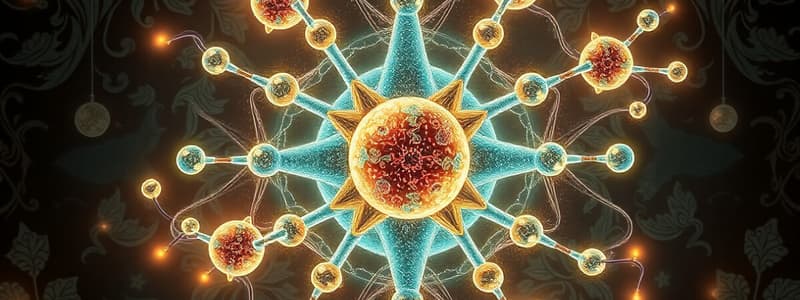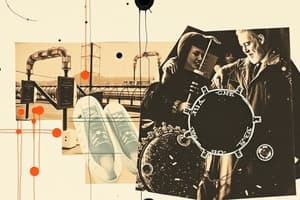Podcast
Questions and Answers
Which type of interatomic bond involves the sharing of electrons between atoms?
Which type of interatomic bond involves the sharing of electrons between atoms?
- Metallic bond
- Ionic bond
- Van der Waals force
- Covalent bond (correct)
What characteristic is associated with materials that possess metallic bonds?
What characteristic is associated with materials that possess metallic bonds?
- Low thermal conductivity
- Brittleness and poor ductility
- High electrical conductivity (correct)
- Transparency to light
In ionic bonding, what causes the attraction between atoms?
In ionic bonding, what causes the attraction between atoms?
- Electrostatic attraction between oppositely charged ions (correct)
- Weak intermolecular forces
- Sharing of valence electrons
- Delocalized electron clouds
How does increasing temperature typically affect the interatomic distance in a solid material?
How does increasing temperature typically affect the interatomic distance in a solid material?
What best describes the structure of an amorphous solid?
What best describes the structure of an amorphous solid?
Why do metals exhibit reflective properties?
Why do metals exhibit reflective properties?
Valence electrons play a primary role in determining:
Valence electrons play a primary role in determining:
Which factor would lead to a decrease in interatomic distance?
Which factor would lead to a decrease in interatomic distance?
A metal with a face-centered cubic (FCC) structure has atoms at each corner of the cube and at the center of each face. How many atoms are contained within each FCC unit cell?
A metal with a face-centered cubic (FCC) structure has atoms at each corner of the cube and at the center of each face. How many atoms are contained within each FCC unit cell?
Which of the following characteristics is most indicative of an amorphous material compared to a crystalline material?
Which of the following characteristics is most indicative of an amorphous material compared to a crystalline material?
A material is known to have a crystal structure where atoms are located at each of the eight corners of a cube. However, there are no other atoms within the unit cell. What is this crystal structure called, and how many atoms does the unit cell contain?
A material is known to have a crystal structure where atoms are located at each of the eight corners of a cube. However, there are no other atoms within the unit cell. What is this crystal structure called, and how many atoms does the unit cell contain?
Iron (Fe) is known to have a body-centered cubic (BCC) crystal structure at room temperature. How many iron atoms are present within each BCC unit cell?
Iron (Fe) is known to have a body-centered cubic (BCC) crystal structure at room temperature. How many iron atoms are present within each BCC unit cell?
What distinguishes a crystalline material from an amorphous material at the atomic level?
What distinguishes a crystalline material from an amorphous material at the atomic level?
Consider a material that transitions from quartz to tridymite at 870°C and then to cristobalite at 1470°C. What is this phenomenon, where a material can exist in multiple crystal structures, called?
Consider a material that transitions from quartz to tridymite at 870°C and then to cristobalite at 1470°C. What is this phenomenon, where a material can exist in multiple crystal structures, called?
Which of the following is correct regarding unit cells?
Which of the following is correct regarding unit cells?
A hypothetical metal exhibits a crystal structure with atoms arranged in a repeating pattern in two dimensions but lacks regularity in the third dimension. How would you classify this material?
A hypothetical metal exhibits a crystal structure with atoms arranged in a repeating pattern in two dimensions but lacks regularity in the third dimension. How would you classify this material?
Flashcards
Protons
Protons
Positively charged particles in the nucleus of an atom.
Neutrons
Neutrons
These are uncharged particles found in the nucleus of an atom.
Valence Electrons
Valence Electrons
The electrons furthest from the nucleus; determine chemical properties.
Covalent Bond
Covalent Bond
Signup and view all the flashcards
Ionic Bond
Ionic Bond
Signup and view all the flashcards
Metallic Bond
Metallic Bond
Signup and view all the flashcards
Van der Waals Forces
Van der Waals Forces
Signup and view all the flashcards
Crystalline
Crystalline
Signup and view all the flashcards
Unit Cell
Unit Cell
Signup and view all the flashcards
Simple Cubic (SC)
Simple Cubic (SC)
Signup and view all the flashcards
Body Centered Cubic (BCC)
Body Centered Cubic (BCC)
Signup and view all the flashcards
Face Centered Cubic (FCC)
Face Centered Cubic (FCC)
Signup and view all the flashcards
Amorphous Structure
Amorphous Structure
Signup and view all the flashcards
Glass Transition Temperature
Glass Transition Temperature
Signup and view all the flashcards
Partially Crystalline
Partially Crystalline
Signup and view all the flashcards
Polymorphism
Polymorphism
Signup and view all the flashcards
Study Notes
- The structure of matter will be described
- Dr/Diaa Elmwafy is the presenter
Atomic Structure
- Atoms comprise a nucleus containing positive protons and uncharged neutrons, along with negative electrons.
- Atoms are the fundamental units of internal structures.
- Physical and chemical properties depend on the interaction between valence electrons furthest from the nucleus.
- Elements, excluding inert gases, strive for a stable configuration of 8 outer electrons.
- This is achieved by gaining (receiving -ve charge), losing (giving +ve charge), or sharing electrons between atoms to complete the outer shell.
Interatomic Bonding
- Interatomic bonding is a primary, strong intramolecular bond
- Covalent, ionic, and metallic bonds are types of interatomic bonds.
- Intermolecular bonding is a secondary, weak bond
Bonding Types
-
Covalent bonds involve sharing electrons.
-
An example is the H2 gas molecule.
-
Covalent bonds are very strong and are insulators, forming basic polymer bonds
-
Ionic bonds involve electrostatic attraction between unlike charges.
-
An example is NaCl forming Na+ cations and Cl- anions.
-
Ionic bonds are insulators, heat resistant, and are commonly used in ceramics and glasses.
-
Metallic bonds have metal atoms that lose electrons freely moving in valence shells.
-
Metallic bonds consist of positive ion cores held by diffused electron clouds, enabling metal deformability.
-
Metals have high thermal and electric conductivity and are opaque because free electrons absorb light.
-
Metals are reflective or lustrous because electrons re-emit light.
-
Van der Waals forces occur, for example, in H2O molecules.
-
Combinations include ionic & covalent bonds as in Caso4
-
Combinations include metallic & ionic bonds as in Dental Amalgam
-
Combinations have high conductive properties, and are hard & brittle
Interatomic Distance
- Interatomic distance is caused by interatomic repulsive & attractive forces
- Factors affecting Interatomic Distance (IAD):
- Temperature: Increased temperature increases energy and IAD.
- Number of adjacent atoms: Increased number of adjacent atoms decreases IAD.
- Covalent bonding: Increased shared electrons decreases IAD.
- State of matter impacts IAD from gas to liquid to metal.
- Free electron movement increases energy and IAD.
Structure of Solids
- Solids are classified by internal atomic structure and atom or molecule regularity in three spatial directions.
- Crystalline solids have atoms arranged regularly & repetitively in 3 dimensions.
- Space lattice describes the 3D arrangement of atoms, with each atom in a similar position to others.
- Amorphous (non-crystalline) solids have atoms or molecules positioned randomly with no regularity, like gases and liquids
- Semi-Crystalline (Mesomorphous) solids have atoms or molecules arranged with regularity in one or more directions.
Crystalline Structures
- Atomic arrangement patterns: cubic, tetragonal, orthorhombic, monoclinic, triclinic, hexagonal, and rhombohedral.
- The unit cell is the smallest repeated unit in crystal lattice.
- Space lattice type is defined by the length of 3 unit cell axes and the angles between them.
Cubic Unit Cells
- Simple Cubic (SC): Each corner atom is associated with 8 surrounding cells, with 1/8 of its volume in each cell.
- SC contains one metal atom per unit cell and has 8 atoms * 1/8 at each corner = 1 atom.
- Body Centered Cubic (BCC): One atom at each of the 8 corners of the cube and another at the unit cell's center = 2 atoms per unit cell.
- Its atoms are 8 atoms * 1/8 at each corner + 1 atom in the center = 2 atoms.
- Examples are iron and chromium.
- Face Centered Cubic (FCC): One atom at each of the 8 corners of the cube and another at the center of each face of the unit cell.
- There are 4 atoms per unit cell in FCC
- Its atoms are 8 atoms * 1/8 at each corner + 6 atom * 1/2 in the center = 4 atoms.
- Examples are copper, gold, platinum, and silver.
Non-Crystalline Structures
- Amorphous structures such as gases or liquids, have random molecules
Properties of Non-Crystalline Structures
- Higher internal energy exists
- Amorphous structures lack a definite melting temperature; they soften gradually as temperature increases and harden when cooled.
- They possess a glass transition temperature where the coefficient of thermal expansion sharply increases, indicating higher molecular mobility.
Semi-Crystalline Structures
- Semi-crystalline structures have definite regularity in one or more directions, such as pyrolytic carbon.
Polymorphism
- Polymorphism occurs when materials with identical chemical compositions exhibit different polymorphic or allotropic forms.
- An example of allotrophy is silica in dentistry.
- Quartz (hexagonal) transforms into tridymite (rhombohedral) at 870°C, then into cristobalite (cubic) at 1470°C, and finally into fused quartz (amorphous) at 1713°C.
Imperfections in Crystalline Solids
- Point defects involve:
- Vacancies where atoms are missing due to imperfect packing during crystallization or thermal vibrations at high temperatures, increasing the likelihood of atoms jumping out.
- Interstitial impurities occur when extra atoms are within a crystal structure.
- The presence of point defects causes atomic distortion within the crystal lattice.
- Line defects involve the displacement of a row of atoms from their normal lattice positions, known as dislocation.
- Plastic deformation in metals results from dislocation movement.
- Plane defects include grain boundaries in metals.
Studying That Suits You
Use AI to generate personalized quizzes and flashcards to suit your learning preferences.
Related Documents
Description
Explanation of atomic structure, focusing on the nucleus, protons, neutrons, and electrons. It describes interatomic bonding as a primary intramolecular bond, including covalent, ionic, and metallic types. Covalent bonds are exemplified with the H2 molecule.




